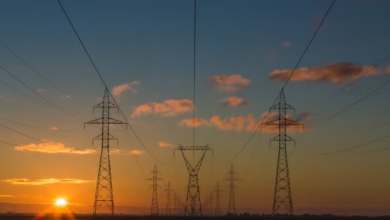Navigating the Energy Transition: How Renewable Energy and Innovative Solutions are Key to Combating Climate Change

As the world grapples with the pressing challenge of climate change, the role of energy has never been more pivotal. Energy consumption is intricately linked to global warming, and transitioning to sustainable energy sources is essential for mitigating its effects. This article delves into the multifaceted relationship between energy and climate change, exploring how renewable energy sources such as solar power, wind energy, hydropower, and bioenergy are essential in combating global warming. We will examine the ongoing energy transition, shedding light on the complexities of fossil fuels versus green energy and their impacts on global energy trends. Additionally, we will highlight innovative solutions like energy storage, smart grids, and carbon capture technologies that are shaping the future of energy policy and ensuring energy security. As we navigate through this crucial period of energy investment and innovation, understanding the dynamics of energy markets and the importance of energy efficiency becomes vital. Join us as we uncover the pathways that can lead us towards a more sustainable and resilient energy landscape, ultimately fostering a healthier planet for future generations.
- 1. The Energy Transition: How Renewable Energy is Paving the Way to Combat Climate Change
- 2. Fossil Fuels vs. Green Energy: Understanding the Impact on Global Energy Trends
- 3. Innovative Solutions: Exploring Energy Storage, Smart Grids, and Carbon Capture Technologies
1. The Energy Transition: How Renewable Energy is Paving the Way to Combat Climate Change
The energy transition is a critical component in the fight against climate change, as it signifies a shift from traditional fossil fuels to renewable energy sources. This transition is essential for reducing greenhouse gas emissions and mitigating global warming. Renewable energy, including solar power, wind energy, hydropower, and bioenergy, plays a pivotal role in creating a sustainable energy future.
As countries worldwide strive to meet their climate goals, energy policies are increasingly favoring green energy solutions. For instance, investments in solar power and wind energy have surged, leading to a significant decline in the costs associated with these technologies. This progress fosters energy efficiency and enhances energy security by reducing reliance on fossil fuel imports. In tandem, energy storage technologies, such as batteries and pumped hydro storage, are crucial for managing the intermittent nature of renewable energy sources.
Moreover, the integration of smart grids allows for better energy management and distribution, ensuring that renewable energy can be efficiently utilized across energy markets. This innovation not only supports energy transportation but also aids in the development of distributed energy systems, which empower local communities to generate and consume energy sustainably.
Nuclear energy also plays a role in the energy transition, providing a low-carbon alternative to fossil fuels. While it comes with its own set of challenges, advancements in nuclear technology, such as small modular reactors, are being explored as part of a diversified energy portfolio.
In addition to these technologies, carbon capture and hydrogen energy are emerging as vital strategies in the energy transition. Carbon capture can help mitigate emissions from existing fossil fuel infrastructure, while hydrogen energy presents a clean fuel option that can be produced from renewable sources.
The ongoing evolution of energy R&D is crucial for driving these innovations. With continued investment in energy technologies, we can expect to see increased efficiency and lower costs, further accelerating the transition to a low-carbon economy. The synergy of various renewable energy sources, coupled with enhanced energy economics and supportive energy policies, will pave the way for a sustainable future that addresses climate change effectively.
In summary, the energy transition is not just about replacing fossil fuels with renewable energy; it involves a comprehensive approach that encompasses energy efficiency, innovative technologies, and strategic energy investments. This multifaceted approach is essential for fostering a resilient energy landscape capable of combating climate change and promoting global energy trends toward sustainability.
2. Fossil Fuels vs. Green Energy: Understanding the Impact on Global Energy Trends
The debate between fossil fuels and green energy is critical in understanding global energy trends and their implications for climate change. Fossil fuels, including coal, oil, and natural gas, have long been the dominant sources of energy worldwide. They offer high energy density and have historically driven economic growth and energy security. However, their combustion releases significant amounts of greenhouse gases, contributing to global warming and climate change. As per the International Energy Agency (IEA, 2023), fossil fuels accounted for approximately 80% of the world's energy supply, highlighting their overwhelming presence in energy markets.
In contrast, renewable energy sources, such as solar power, wind energy, hydropower, and bioenergy, are gaining traction as viable alternatives. These green energy technologies have shown remarkable advancements in energy efficiency and energy innovations, making them more competitive against traditional fossil fuels. For instance, the cost of solar energy has decreased by over 80% since 2010, leading to a surge in energy investment in solar power projects globally (IRENA, 2023). The transition to renewable energy is essential for achieving energy security and mitigating climate change effects.
Nuclear energy also plays a significant role in the energy transition. It provides a stable and low-carbon energy source, which can complement intermittent renewable energies like solar and wind. As energy storage technologies improve, including battery systems and hydrogen energy solutions, the integration of nuclear energy and renewables becomes increasingly viable. Smart grids enable this integration by facilitating efficient energy transportation and managing energy supply and demand.
Energy policy is crucial in shaping the future of global energy trends. Governments worldwide are implementing policies that promote energy efficiency, carbon capture technologies, and the development of offshore energy resources. These policies help stimulate energy R&D and encourage the adoption of electric vehicles, further reducing dependence on fossil fuels.
As countries move towards a greener economy, understanding the dynamics between fossil fuels and renewable energy is essential. The energy transition not only addresses climate change but also influences energy exports and imports, impacting global energy economics and markets. Ultimately, the shift towards green energy will determine the trajectory of global energy trends and the effectiveness of collective efforts to combat climate change.
References:
International Energy Agency. (2023). World Energy Outlook 2023. [Link to source]
International Renewable Energy Agency. (2023). Renewable Power Generation Costs in 2023. [Link to source]
3. Innovative Solutions: Exploring Energy Storage, Smart Grids, and Carbon Capture Technologies
The pursuit of innovative solutions is crucial in addressing climate change, particularly through advancements in energy technologies. As we transition from fossil fuels to renewable energy sources, several pivotal innovations are emerging to enhance energy efficiency and support the global energy transition.
Energy storage systems play a vital role in ensuring the reliability and stability of renewable energy sources like solar power and wind energy. By capturing excess energy produced during peak generation times, these technologies can release stored energy when demand is high or when renewable generation is low. This not only enhances energy security but also facilitates the integration of distributed energy resources into energy markets. Innovations in battery technologies, such as lithium-ion and flow batteries, are transforming energy storage capabilities, making it feasible to store large quantities of energy for use in electric vehicles and other applications.
Smart grids are another transformative innovation that revolutionizes how we manage and distribute energy. By utilizing advanced sensors and communication technologies, smart grids enhance the efficiency of energy transportation and consumption. They allow for real-time monitoring of energy usage, enabling better demand response strategies and reducing transmission losses. Additionally, smart grids facilitate the integration of various energy sources, including hydropower, bioenergy, and offshore energy, creating a more resilient and adaptable energy infrastructure.
Carbon capture technologies are critical in mitigating the impact of fossil fuels on climate change. By capturing carbon dioxide emissions from power plants and industrial processes, we can significantly reduce greenhouse gas emissions while continuing to utilize fossil fuels for energy generation. This approach aligns with energy policy goals aimed at achieving net-zero emissions. Innovations in carbon capture, utilization, and storage (CCUS) are continually evolving, making these technologies more efficient and cost-effective.
As we embrace these energy innovations, it is essential to prioritize energy investment in research and development (R&D). Continued funding and support for emerging energy technologies will drive advancements in thermal energy, hydrogen energy, and other key areas, ensuring we maintain momentum in combating climate change. By fostering collaboration between government, industry, and academia, we can accelerate the adoption of these innovative solutions, ultimately leading to a more sustainable and resilient energy future.
In conclusion, the integration of energy storage, smart grids, and carbon capture technologies represents a significant leap forward in our efforts to combat climate change. These innovations not only enhance energy efficiency but also pave the way for a cleaner, greener energy landscape, promoting a successful energy transition toward a sustainable future.
In conclusion, the journey toward a sustainable energy future is crucial in combating climate change and ensuring energy security. The energy transition is not just a necessity but an opportunity to reshape global energy trends in favor of renewable energy sources such as solar power, wind energy, hydropower, and bioenergy. As the world grapples with the impacts of fossil fuels, innovative solutions like energy storage, smart grids, and carbon capture technologies are emerging as key players in enhancing energy efficiency and reducing greenhouse gas emissions.
Moreover, investments in nuclear energy and offshore energy initiatives can diversify our energy portfolio while contributing to energy security. By fostering an environment conducive to energy R&D, we can unlock further innovations that will drive the adoption of electric vehicles and distributed energy systems, ultimately transforming our energy markets.
As policymakers focus on energy policy that prioritizes sustainability and climate goals, the path forward will hinge on a collective commitment to embracing energy innovations and fostering collaboration across sectors. As we move forward, it is imperative to continue investing in the technologies and strategies that will ensure a resilient and efficient energy landscape capable of meeting the demands of a changing climate. Together, through strategic energy investments and a commitment to green energy, we can turn the tide on climate change and build a sustainable future for generations to come.





